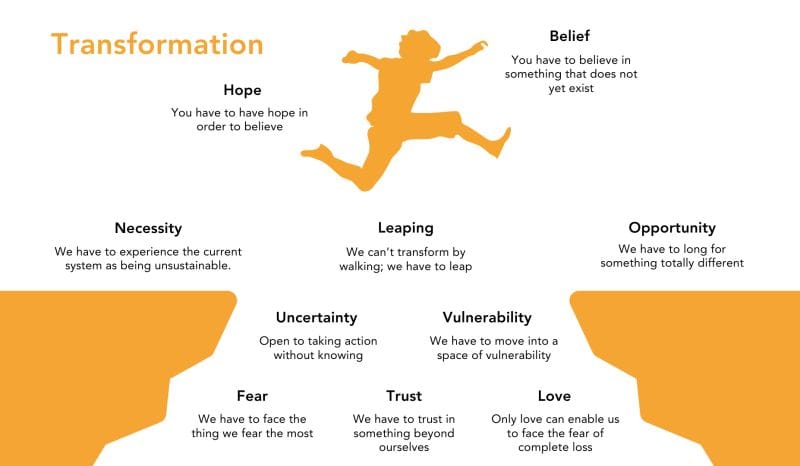Transformation Requires a Leap: Why Belief, Vulnerability, and Courage Are the Keys to Change
Real transformation demands bold leaps, not cautious steps. Discover how hope, vulnerability, and courage can unlock lasting change—and how to lead your team through it. Are you ready to leap?

David Lloyd George once said, “There is no greater mistake than to try to leap an abyss in two jumps.”
This metaphor has always resonated with me, both personally and professionally. It captures the essence of transformation: a bold, all-in commitment to change. Over the past decade, I’ve worked with startups, medium-sized businesses, and large enterprises, guiding them through agile coaching, product management, and storytelling. Time and again, I’ve seen that real transformation isn’t about cautious steps or half-measures. It’s about leaping into the unknown.
But leaping is hard. It requires hope, belief, vulnerability, and the courage to confront fear. It means longing for something totally different and being open to taking action without knowing the outcome.
In this post, I’ll explore the human side of transformation—the emotions, mindsets, and actions that make it possible. I’ll also share insights from my experience, reference external sources to enrich the discussion, and offer guidance for leaders and teams ready to take the leap.
The Role of Hope and Belief in Transformation
Transformation begins with hope.
Hope is the spark that ignites change. It’s the belief that something better is possible, even when the current system feels unsustainable. I’ve seen this play out in organizations time and time again. A startup on the brink of failure finds hope in a new vision. A large enterprise stuck in outdated processes discovers hope in agile methodologies.
But hope alone isn’t enough. You also need belief—belief in yourself, your team, and the possibility of change. Belief is what keeps you moving forward when the path is uncertain. It’s what allows you to leap, even when you can’t see the other side of the abyss.
Research supports the power of belief in driving transformation. A study published in the Harvard Business Review found that organizations with a strong sense of purpose and belief in their mission are more likely to achieve long-term success. Similarly, a Reddit thread on r/Leadership highlighted how leaders who foster a culture of belief and optimism are better equipped to navigate uncertainty and inspire their teams to take bold actions.
Why We Can’t Transform by Walking
The image you’re seeing here says it perfectly: “We can’t transform by walking; we have to leap.”
Walking implies small, cautious steps. It’s safe, predictable, and comfortable. But transformation isn’t any of those things. It’s messy, uncertain, and often uncomfortable.
I’ve worked with teams that tried to “walk” their way to change. They made incremental adjustments, hoping to avoid disruption. But in the end, they found themselves stuck in the same patterns, unable to achieve the breakthrough they needed.
Leaping, on the other hand, requires courage. It means letting go of the familiar and stepping into a space of vulnerability. It means trusting that the leap will take you somewhere better, even if you can’t fully see the destination.
This idea is echoed in a popular Reddit discussion on r/Entrepreneur, where users shared stories of how taking bold, decisive actions—rather than incremental steps—led to their most significant breakthroughs. One user recounted how pivoting their entire business model, despite the risks, saved their startup from failure and unlocked new growth opportunities.
The Space of Vulnerability: Where Transformation Happens
Vulnerability is at the heart of transformation.
When we leap, we expose ourselves to fear, uncertainty, and the possibility of failure. But we also open ourselves up to growth, connection, and new possibilities.
In my work with organizations, I’ve seen how vulnerability can transform teams. When leaders admit they don’t have all the answers, it creates a culture of trust and collaboration. When teams embrace uncertainty, they become more agile and innovative.
Vulnerability isn’t weakness—it’s strength. It’s the willingness to confront the thing we fear the most and leap anyway.
Brené Brown, a renowned researcher on vulnerability, emphasizes this point in her TED Talk, “The Power of Vulnerability.” She argues that vulnerability is the birthplace of innovation, creativity, and change. This resonates deeply with my experience working with teams. Those who embrace vulnerability are often the ones who achieve the most profound transformations.
Fear, Trust, and Love: The Emotions of Transformation
Transformation is an emotional journey. It’s not just about strategies and processes; it’s about the human experience.
- Fear: Fear is natural. It’s what we feel when we stand at the edge of the abyss, unsure of what’s on the other side. But fear doesn’t have to hold us back. When we acknowledge it and leap anyway, we turn fear into fuel for change.
- Trust: Trust is the foundation of any successful transformation. It’s what allows teams to take risks, make mistakes, and learn together. As a leader, your job is to build trust—in yourself, your vision, and your team.
- Love: Love might seem out of place in a business context, but it’s essential. Love is what drives us to care deeply about our work, our customers, and our teams. It’s what keeps us committed to the leap, even when the journey is hard.
A Reddit thread on r/Management highlighted how leaders who prioritize trust and emotional connection with their teams are more successful in driving change. One commenter shared how their CEO’s openness about their own fears and struggles created a culture of trust that empowered the entire organization to take bold steps.
How to Take the Leap: Practical Guidance for Leaders
So, how do you take the leap? How do you move from hope and belief to action?
Here are a few principles I’ve learned from my work in agile coaching, product management, and storytelling:
1. Clarify Your Vision
Before you leap, you need to know what you’re leaping toward. What’s the vision driving your transformation? What does success look like? Clarity of purpose is essential.
2. Build a Culture of Trust
Leaping is easier when you’re not doing it alone. Foster a culture of trust where your team feels safe to take risks and make mistakes.
3. Embrace Iterative Learning
Leaping doesn’t mean you have to get it perfect the first time. Use agile methodologies to test, learn, and adapt as you go.
4. Tell the Story
Storytelling is a powerful tool for transformation. Craft a narrative that inspires your team to leap with you.
You Don’t Have to Leap Alone
Leaping is hard, but it’s easier when you have the right support.
Over the years, I’ve worked with organizations at every stage of their journey—from startups to large enterprises. My role has always been to help them navigate the uncertainty of transformation, whether that’s through agile coaching, product strategy, or storytelling.
If you’re standing at the edge of your own abyss, wondering how to take the leap, know that you don’t have to do it alone. With the right guidance, you can craft a strategy that aligns with your vision, build a culture of trust and innovation, and inspire your team to leap with you.
Final Thoughts: The Leap Is Worth It
Transformation isn’t easy. It requires hope, belief, vulnerability, and the courage to confront fear. But here’s the thing: The leap is always worth it.
When you take the leap, you don’t just cross the abyss—you transform what’s possible. You create new opportunities, unlock new potential, and inspire others to do the same.
So, what’s your abyss? And are you ready to leap?




